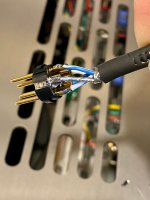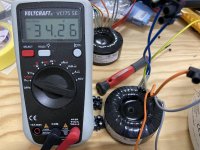Hi guys, i seek advice in regards to RAW PSU. Have assembled it and measured DC output voltage that varies from 48-49.5VDC.
Is this ok?
I have 2 x 50VA 230V/31VAC toroid transformer but is seems my home voltage grid varies from 235-240V instead 230V.
Is this ok?
I have 2 x 50VA 230V/31VAC toroid transformer but is seems my home voltage grid varies from 235-240V instead 230V.
Better be under 45 volts. If you used the PSU board from the group buy there should be a resistor after the rectifier diodes to limit voltage.
But measure the raw PSU's output when loaded for 100mA. 470 Ohm 5W dummy load resistors will do.
Hello guys, I need some help in troubleshooting in my 2015 FSP.
I have done the below and my analysis.
Please let me know on any other suggestions on where to check? Or possibility on other problems?
Only Q1 is populated, aiming for ~57db gain
Ch1
Only d1-4 no light
Q7 ds resistance is 17ohm
Q3x & Q5x, ds resistance is 77ohm
Q4x vbe is 0.79
Rail and input dc is 44v & 38v.
Between Tp1 & tp2 is -0.07v
- Suspect K117 at Q7 is gone, thus D1-4 not lighted and thus cannot bias and seeing TP1/2 voltage above.
Puzzling ch2
Input 51v
Rail is 22v, cannot be adjusted via VR2x
All leds lights
Bias between Tp 1 & tp2 can adjust to 3-4 via VR2x and VR1
Q3x & Q5x, ds resistance is 15ohm
Q4x vbe is 0.79
Q1x warmer than q6x
- Suspect K117 at Q3x & Q5x is gone thus Rail voltage got stuck.
I have done the below and my analysis.
Please let me know on any other suggestions on where to check? Or possibility on other problems?
Only Q1 is populated, aiming for ~57db gain
Ch1
Only d1-4 no light
Q7 ds resistance is 17ohm
Q3x & Q5x, ds resistance is 77ohm
Q4x vbe is 0.79
Rail and input dc is 44v & 38v.
Between Tp1 & tp2 is -0.07v
- Suspect K117 at Q7 is gone, thus D1-4 not lighted and thus cannot bias and seeing TP1/2 voltage above.
Puzzling ch2
Input 51v
Rail is 22v, cannot be adjusted via VR2x
All leds lights
Bias between Tp 1 & tp2 can adjust to 3-4 via VR2x and VR1
Q3x & Q5x, ds resistance is 15ohm
Q4x vbe is 0.79
Q1x warmer than q6x
- Suspect K117 at Q3x & Q5x is gone thus Rail voltage got stuck.
Ch1 Q7 most likely gone or there is some problem at its solder joints. Q3x Q5x measured at 77 Ohm RDS is reasonable.
Ch2 Q3x Q5x suspects yes, remove them to confirm RDS & IDSS, but before that see if Q6x is the reason. Measure its VDS. 3-4 VDC is normal. Confirm R3x's value also.
Ch2 Q3x Q5x suspects yes, remove them to confirm RDS & IDSS, but before that see if Q6x is the reason. Measure its VDS. 3-4 VDC is normal. Confirm R3x's value also.
being at one of those so simple steps, not seeing the solution...
Hi again
I am anxious I could bungle the connection of my trannies to the raw PSU...
I have two TTSA0030 Audiograde 2 x 16V 30VA to connect. They're dual secondaries.
I connect them in series, right? Anything I should take special care of (like, polarity)?
Has anyone a sketch/foto/schematic available onto which I could have a peek?
Thanks, and happy weekend!
david
Hi again
I am anxious I could bungle the connection of my trannies to the raw PSU...
I have two TTSA0030 Audiograde 2 x 16V 30VA to connect. They're dual secondaries.
I connect them in series, right? Anything I should take special care of (like, polarity)?
Has anyone a sketch/foto/schematic available onto which I could have a peek?
Thanks, and happy weekend!
david
Last edited:
Connect the second with the third wire of the four secondary ones. The first and fourth free remaining wires are the new summed secondary ends.
For example a label states SEC 1 are the red & black wires, SEC 2 are the yellow & orange wires. You tie together black & yellow. The free remaining red & orange are your new series secondary with double the voltage.
For example a label states SEC 1 are the red & black wires, SEC 2 are the yellow & orange wires. You tie together black & yellow. The free remaining red & orange are your new series secondary with double the voltage.
Ah, perfect!
(
toroidy audio-transfos are even simpler: the wire's are colored by pairs, so for example price = 2 blue, sec = two white, two brown and a yellow-green to put it to ground...
So 1 white + 1 brown go together, the other to the psu...
)
Many thanks, Salas!
(
toroidy audio-transfos are even simpler: the wire's are colored by pairs, so for example price = 2 blue, sec = two white, two brown and a yellow-green to put it to ground...
So 1 white + 1 brown go together, the other to the psu...
)
Many thanks, Salas!
The yellow green should be the internal static screen drain wire.
[emoji1317]
Ah, perfect!
So 1 white + 1 brown go together, the other to the psu...
They still need to be in series and that is tricky with same coloured secondary's. Connect a brown and white together and measure the output voltage before connecting to the power supply. If you get 2 X the secondary AC voltage you are good. If you see less or very little AC then change just 1 of either the brown or white to get them in series.
Last edited:
They still need to be in series and that is tricky with same coloured secondary's. Connect a brown and white together and measure the output voltage before connecting to the power supply. If you get 2 X the secondary AC voltage you are good. If you see less or very little AC then change just 1 of either the brown or white to get them in series.
Thank you, TUM!
I did so and the results are weird:
I connect the inner secondaries (orange-grey) and get 0.003v
I connect two outer secondaries (orange-grey) and get 0.0v
...
Faulty dmm or anything else?
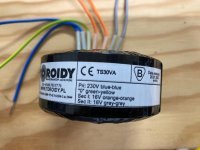
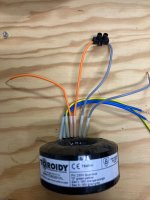
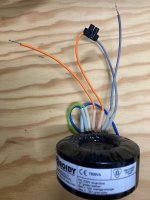
One of the arrangements should have given you the 32 volts. I'm sure you would have set the meter to AC volts but just confirming?
Thank you, ZUM911!
Follow-up question: Is it recommended to separate the UFSP and the UBIB 1.35?
another thank you 😀
david
Follow-up question: Is it recommended to separate the UFSP and the UBIB 1.35?
another thank you 😀
david
- Home
- Source & Line
- Analogue Source
- Simplistic NJFET RIAA
